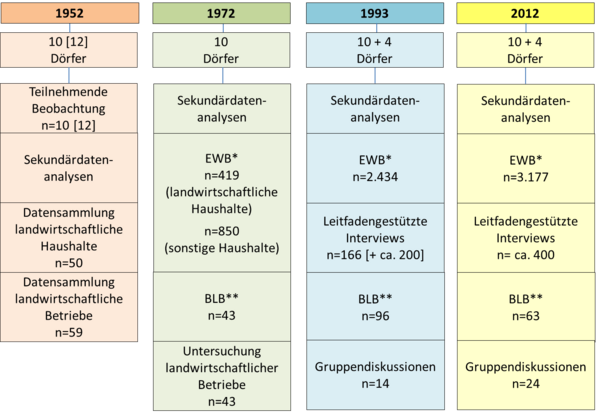Expertise
"Rural living conditions in transition 1952, 1972, 1993, 2012": a unique long-term study
Annett Steinführer | 11.05.2022
Ten West German municipalities have been studied regularly since the 1950s, and four East German municipalities have supplemented the long-term study since 1993. Longitudinal analyses such as these are very rare in social research, because effort and costs are high, and continuity cannot always be guaranteed.

In 1952, the Research Association for Agricultural Policy and Agricultural Sociology (FAA) was founded in Bonn with the aim of acting as a mediator between science and politics in the context of structural changes in agriculture. Its central theme was small-scale agriculture and its contribution to food security in postwar West Germany. Federal policymakers, who were themselves involved in consultations on the FAA's research program in the person of the Federal Minister of Food, Agriculture and Forestry, among others, expected the studies to provide indications of necessary socio-agricultural measures.
For the FAA's first study, ten villages with different agricultural, farm and social structures were selected to investigate the present of smallholder villages and to develop concepts for the future. Some of these villages had been pre-classified as "active" (or "dynamic") villages, others as "passive" (or "lagging") villages. During one-year study visits in the field, so-called investigators (mostly farmers themselves, and among them just one woman) collected a great deal of data from the perspectives of home economics, agricultural economics, family sociology and village sociology.
At the beginning of the 1970s, the idea arose to return to the ten villages and study their level of development in the context of general social change. Once again, this investigation was led by the FAA. The characterization as "smallholder" was now considered outdated in light of the advanced structural changes in agriculture. Rather, villages had been transformed into rural housing estates, and it was issues of out-migration of younger population groups and (socio-)demographic development that seemed more pressing.
These problems were still considered paramount in the follow-up studies of the 1990s and 2010s, although the multifaceted nature of village development paths increasingly came to the fore. Four East German villages have completed the sample since the third survey. In 1993, the FAA remained responsible, and after its dissolution in 2004, the Thünen Institute was entrusted with the continuation in 2012 with the management of the study - which in all four survey waves always represented an association of different research institutes and universities.
Such longitudinal analyses are very rare in social research, because effort and costs are high, and the continuity of research personnel and institutions cannot always be guaranteed. It is planned to continue the study at the beginning of the 2030s.
Further literature (in German)
Becker H (1997) Ländliche Lebensverhältnisse im Wandel 1952, 1972 und 1993/95. Bonn.
Becker H, Tuitjer G (2019) 60 Jahre „Ländliche Lebensverhältnisse im Wandel“ – wie eine Langzeitstudie entsteht. In: Steinführer A, Laschewski L, Mölders T, Siebert R (Hrsg.) Das Dorf. Soziale Prozesse und räumliche Arrangements. Berlin, 79-89.
BMEL [Bundesministerium für Ernährung und Landwirtschaft] (Hg.) (2015) Ländliche Lebensverhältnisse im Wandel 1952, 1972, 1993 und 2012. Redaktion: Thünen-Institut für Ländliche Räume und BMEL. Berlin.





